Wartsila to deliver its first ammonia ship engine in early 2025

Ship engine manufacturer Wartsila expects to deliver its first ammonia-fuelled engine on a new vessel in early 2025, with more widespread sales expected in the 2030s, a company executive told Reuters.
Ammonia is among several alternative fuels that shippers are exploring to reduce carbon emissions.
The company launched its first ammonia four-stroke engine for orders in the fourth quarter last year, with the first such engine to be delivered early next year on a vessel, Roger Holm, president of marine and executive vice president at Finland-based Wartsila, said this week.
He added that there has been rising interest from clients for alternative fuel engines due to the latest European Union regulations.
The company declined to comment on the client and the type of ship for now.
“Ship owners are becoming increasingly focused on future-proofing their fleets, and are aware of the evolving regulatory landscape for maritime decarbonisation,” Holm said.
“As a result, we could expect to see sales of ammonia engines rise rapidly before 2030 with first adoption from major industry players, before becoming widespread in the 2030s,” Holm added.
He estimated that green fuels could potentially make up about 5% to 10% of the global bunker market by 2030, but expects “decades” before a major uptake of green fuels in shipping as limited production capacity will pose challenges.
“The engine technology is there but the key here will be fuel availability. I think that’s the biggest restriction in getting the uptake of green fuel,” said Holm.
While methanol-fuelled engines have gained more traction in recent years, broader sales of ammonia engines are expected to take off only in the 2030s.
“The issue with ammonia is that it’s 3.9 times the (onboard handling) space needed of traditional fuels,” he said, adding that methanol only takes 1.7 times more space in comparison.
He expects ammonia to catch up in the long termas its main benefit is that it can be burned without emitting carbon.
“We see most interest from a customer perspective from Norway, and to some extent also I think Japan will be a front runner,” Holm said.
Ammonia does not contain carbon but is toxic in nature, requiring more stringent safety measures when handled as a marine fuel.
Source: Reuters (Reporting by Jeslyn Lerh, Editing by Alexandra Hudson)
Source link
